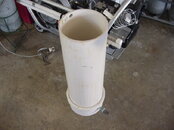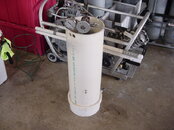w ripley
Contributor
I've been running one for probably 5 years now. FYI, I've had a lot of problems with the 3rd stage seals, and have to replace at least once per year. The compressor still pumps, but pretty slowly when that seal goes. The head bolts are round heads with internal phillips fittings. Suggest you order new head bolts when if you have to replace your seals, as they go about every other time you loosen and retighten them. Guess that comes with buying a compressor made in Turkey.
I fill my tanks in a tub. They're going to get warm-to-hot filling them out of water. It just saves a lot of time filling that way, especially when blending several gases like O2 and HE (nitrox or trimix). Just takes too long to let them settle down on their own, especially during the summer. I normally pump my tanks to 3,600 psi, more if doing a long push or deep dive, so they're going to get hot. Water is what every tech fill station puts their tanks in to offset this.
The compressor is sending out a hot air mix, and it's going directly into your tanks. You know this. So, your tanks are going to get relatively hot, but not like you are describing. Truthfully, you don't have a 3.5 CF/M compressor, because everytime it bleeds you have to subtract what you're bleeding off from the final amount being pumped. If you never blead it you would have 3.5 CF/M, but that's not how the self bleeders work. So, your tanks shouldn't be getting that hot from 2.5 +/- CFM. It's a pretty small compressor.
I pump into 6 high pressure cascaded storage tanks and maintain them at 4,000 psi. That gives me approximately 2,400 cf to work with. The only time my dive tanks ever get really "HOT" is if I try to put too much in too fast from those storage tanks, not directly from the compressor.
BTW: I have my compressor in a detached garage. It takes hours and hours to fill the storage tanks after a big fill so I have a light connected to the compressor that comes on when it is running. The light is mounted outside the garage so that I can see it from my kitchen. That way I always know whether or not the compressor is on anytime of the year and when it's finished topping off the storage bottles.
Regards,
Bill
I fill my tanks in a tub. They're going to get warm-to-hot filling them out of water. It just saves a lot of time filling that way, especially when blending several gases like O2 and HE (nitrox or trimix). Just takes too long to let them settle down on their own, especially during the summer. I normally pump my tanks to 3,600 psi, more if doing a long push or deep dive, so they're going to get hot. Water is what every tech fill station puts their tanks in to offset this.
The compressor is sending out a hot air mix, and it's going directly into your tanks. You know this. So, your tanks are going to get relatively hot, but not like you are describing. Truthfully, you don't have a 3.5 CF/M compressor, because everytime it bleeds you have to subtract what you're bleeding off from the final amount being pumped. If you never blead it you would have 3.5 CF/M, but that's not how the self bleeders work. So, your tanks shouldn't be getting that hot from 2.5 +/- CFM. It's a pretty small compressor.
I pump into 6 high pressure cascaded storage tanks and maintain them at 4,000 psi. That gives me approximately 2,400 cf to work with. The only time my dive tanks ever get really "HOT" is if I try to put too much in too fast from those storage tanks, not directly from the compressor.
BTW: I have my compressor in a detached garage. It takes hours and hours to fill the storage tanks after a big fill so I have a light connected to the compressor that comes on when it is running. The light is mounted outside the garage so that I can see it from my kitchen. That way I always know whether or not the compressor is on anytime of the year and when it's finished topping off the storage bottles.
Regards,
Bill





